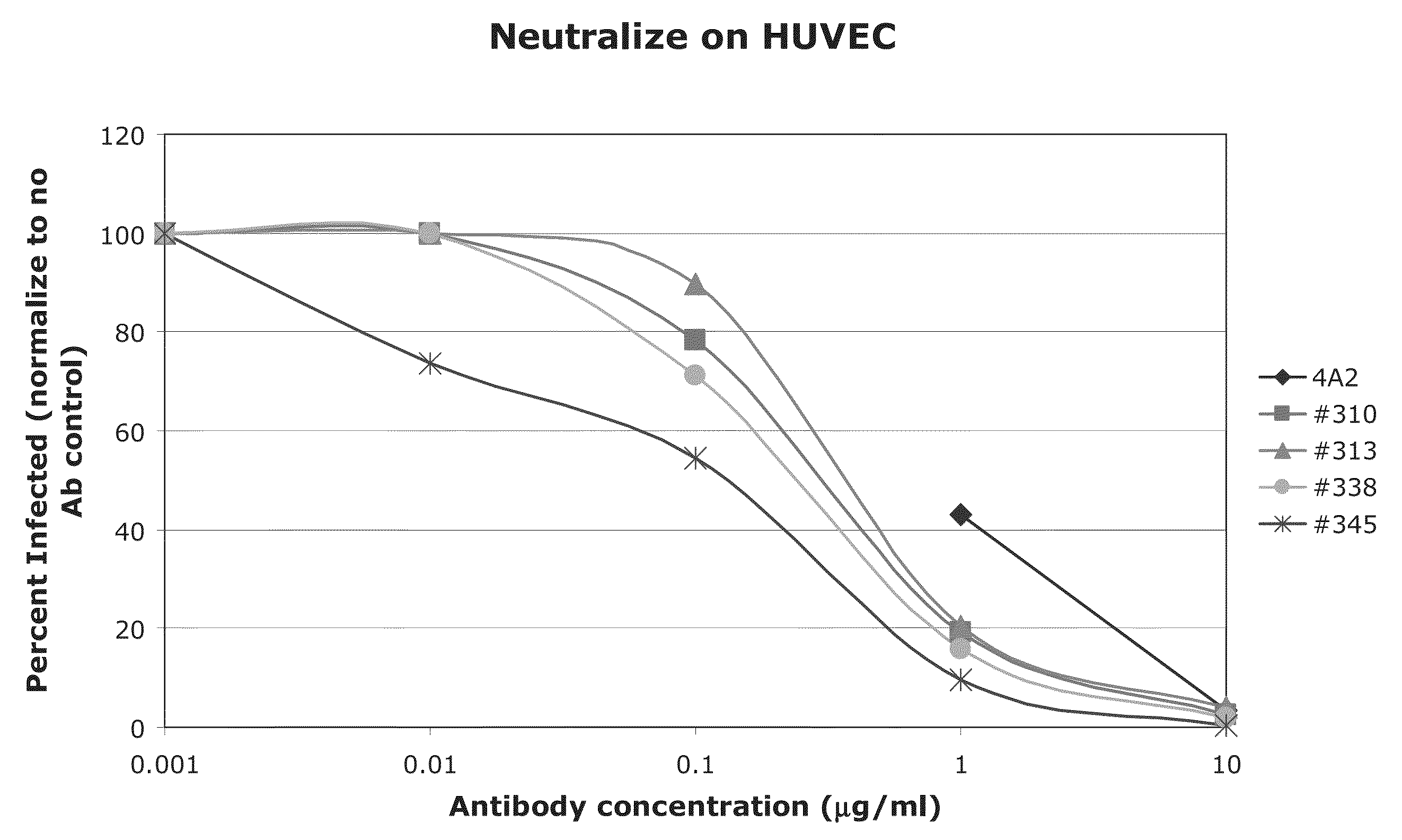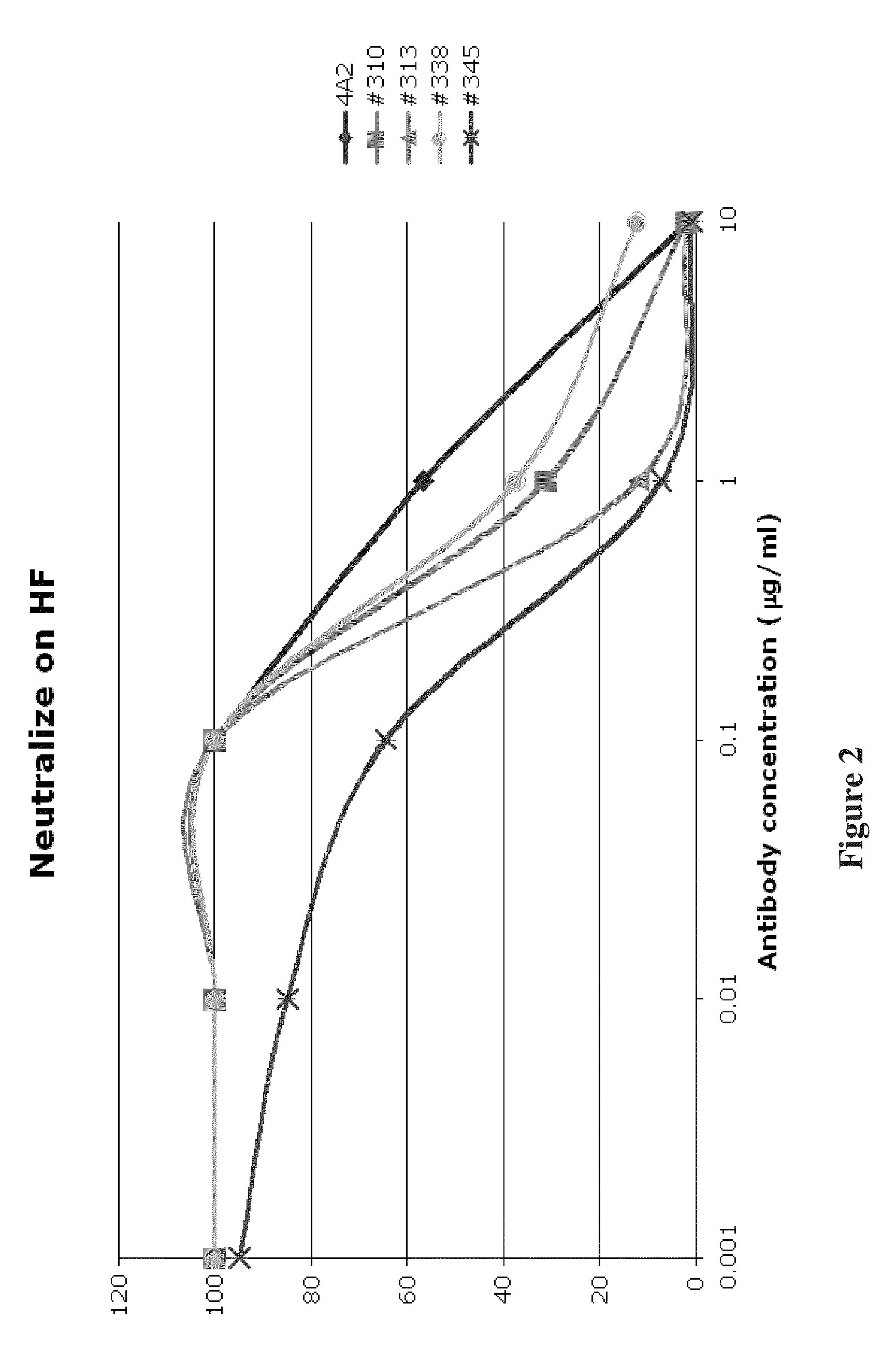High affinity human antibodies to human cytomegalovirus (CMV) gB protein
a human cytomegalovirus and high affinity technology, applied in the field of human monoclonal antibodies (mabs) against the gb protein of cmv, can solve the problems of limited efficacy, limited scope, and no high affinity (sub-nanomolar) antibodies have been described, and achieve the effect of improving affinity and neutralizing ability
- Summary
- Abstract
- Description
- Claims
- Application Information
AI Technical Summary
Benefits of technology
Problems solved by technology
Method used
Image
Examples
example 1
Isolation of Human B Cells Secreting Antibody to CMV gB
[0035]Peripheral blood mononuclear cells from 50 adults with confirmed titer against CMV were surveyed for human B cells producing anti-viral antibodies. Subjects with the desired antibodies against CMV gB protein were used for cloning of specific mAbs. The result of the survey was that ˜10% of the subjects had a frequency of the desired cells greater than 1 in 50,000.
[0036]To accomplish the survey and recovery of rare favorable cells, we used the previously described CellSpot™ technology (U.S. Pat. No. 7,413,868, incorporated herein by reference). The CellSpot™ assay method effectively shrinks an ELISA equivalent assay down to a virtual well of nearly single cell dimensions by capturing secreted IgG from a single cell as a footprint in the vicinity of the cell, so that millions of cells can be readily analyzed. Further, by use of microscopic multiplexing reagents (combinatorially colored fluorescent latex microspheres, cf U.S. ...
example 2
Cloning of Human Antibodies to CMV gB
[0044]Amplification of rearranged Ig Heavy and Ig Light genes from positive ELISA wells was accomplished using semi-nested polymerase chain reaction (PCR). For amplification of a previously unknown V-gene rearrangements, a collection of family-specific V-gene primers was constructed, which recognize nearly all V-gene segments in the human Ig Locus. The 5′ primers were used together with primer mixes specific for the Cγ, Cκ and Cλ gene segments. The clonality of the limiting dilution CMV-gB specific B cells was unequivocally determined by sequence comparison of V-gene amplificates from distinct progeny cells, and the amplified full length V-gene rearrangements were cloned into IgG expression vectors.
[0045]In detail, total mRNA from the isolated human B cells was extracted using a commercially available RNA purification kit (RNeasy™ Qiagen (Germany)). Reverse transcription-PCR was done by using total RNA preparations and oligonucleotides as primers...
example 3
Affinity Determination
[0054]The affinity of the invention antibodies was determined by FortéBio® (Menlo Park, Calif.) biosensor analysis. In this method, the carboxylic acid groups on Amine Reactive Biosensors were activated with EDC / NHS. Antibody, diluted in MES buffer at pH 5, was attached to the activated surface of the probe and the remaining active carboxylated groups were blocked with ethanolamine. The gB protein was incubated with the Ab-coated probe and rates of association to and dissociation from the Ab-coated probe were determined by the ForteBio® instrument.
[0055]In one experiment, 4A2 was found to have an affinity of 168 μM and 19B10 an affinity of 697 μM, as shown as corresponding IC50 in μg / ml in Table 1. These affinity constants are substantially better than for published monoclonal antibodies to gB.
[0056]
TABLE 1Comparison of neutralizing potency of mAbs.IC50mAb (target)(μg / mL)citationsource4A2 (gB)0.02—human19B10 (gB)0.04—humanCH177 (gB)0.23Nozawa, N, et al. (2009) ...
PUM
| Property | Measurement | Unit |
|---|---|---|
| time | aaaaa | aaaaa |
| pH | aaaaa | aaaaa |
| affinity | aaaaa | aaaaa |
Abstract
Description
Claims
Application Information
 Login to View More
Login to View More - R&D
- Intellectual Property
- Life Sciences
- Materials
- Tech Scout
- Unparalleled Data Quality
- Higher Quality Content
- 60% Fewer Hallucinations
Browse by: Latest US Patents, China's latest patents, Technical Efficacy Thesaurus, Application Domain, Technology Topic, Popular Technical Reports.
© 2025 PatSnap. All rights reserved.Legal|Privacy policy|Modern Slavery Act Transparency Statement|Sitemap|About US| Contact US: help@patsnap.com



